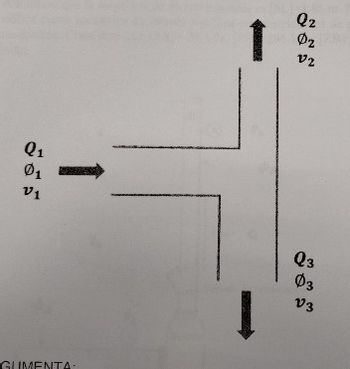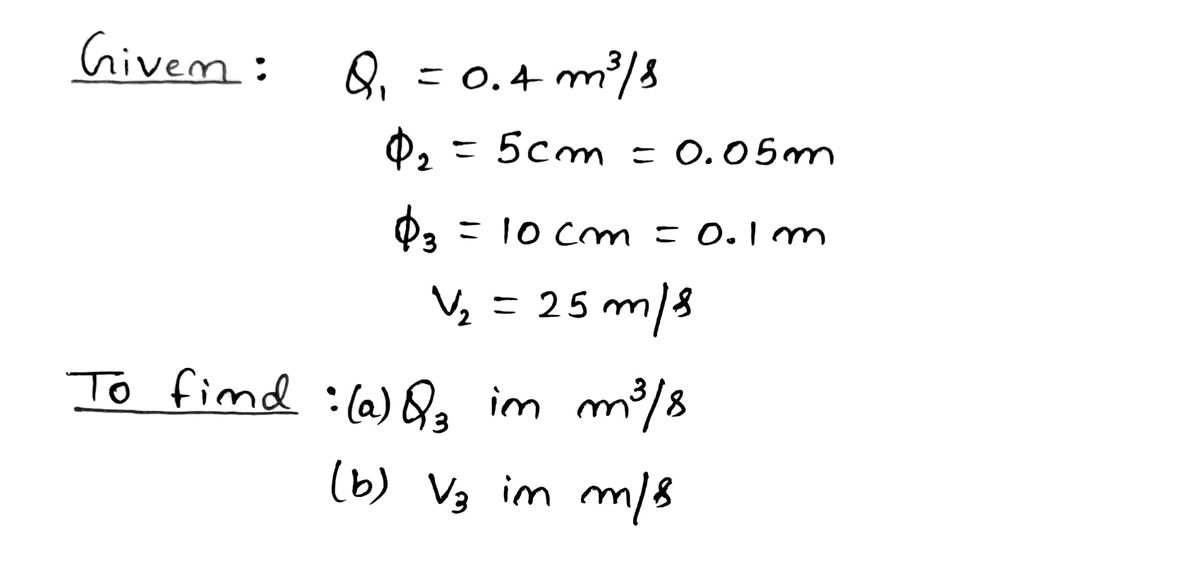
Elements Of Electromagnetics
7th Edition
ISBN: 9780190698614
Author: Sadiku, Matthew N. O.
Publisher: Oxford University Press
expand_more
expand_more
format_list_bulleted
Question
Water enters the piping arrangement shown in the figure at a volumetric flow rate Q1=0.4 m^3/s. The water flow is then divided into pipes of diameter [Theta2] = 5 cm and [Theta3]= 10 cm. If the average speed of the water in pipe 2 is [V2] = 25 m/s. What is the flow rate Q3 in m^3/s in the pipe of diameter theta 3? And at what speed does the fluid leave through pipe 3 in m/s?

Transcribed Image Text:Q₁
01
V1
GUMENTA
Q2
02
V2
Q3
V3
Expert Solution
arrow_forward
Step 1

Step by stepSolved in 2 steps with 2 images

Knowledge Booster
Learn more about
Need a deep-dive on the concept behind this application? Look no further. Learn more about this topic, mechanical-engineering and related others by exploring similar questions and additional content below.Similar questions
- P1 A thin layer of water flows down a plate inclined to the horizontal with an angle a = 15° in the shown coordinate system. If the thickness of the water layer is a=0.5 mm, assuming that the flow is laminar and incompressible, (water density p = 1000 kg/m³viscosity µ = 0.001 Pa.s and acceleration of gravity g = 9.81 m/s²) and an air flow shears the layer in a direction opposite to its flow with a shear stress of 1 N /m². Solve the Navier-Stokes equation: air water (a) to find the value of the maximum water velocity in m/s to three decimal points, Answer: (b)and to find the value of water velocity at the layer's surface in m/s to three decimal points, Answer:arrow_forwardThe velocity for a steady, incompressible flow in the xy plane is given by u=Ax², v= Ayx, where A= 1.2 m1s, x and y in meter. Find the the curl of the velocity vector at the point (0.04 m, 0.01 m): O 0.0000 O 2.3999 O 0.0120 O 0.0005 O 0.0019 O 1.1999 O 0.0000 O 1.2000arrow_forwardA water diffuser is constructed like that in the figure below. Diffuser wall 2 m Flow Entrance 7 m Exit The volumetric flow rate at the entrance (per meter depth into the plane of the image) is 14.0 m2/s and the pressure difference Pexit - Pentrance = 350 kPa. What is the expansion angle in degrees? iarrow_forward
arrow_back_ios
arrow_forward_ios
Recommended textbooks for you
 Elements Of ElectromagneticsMechanical EngineeringISBN:9780190698614Author:Sadiku, Matthew N. O.Publisher:Oxford University Press
Elements Of ElectromagneticsMechanical EngineeringISBN:9780190698614Author:Sadiku, Matthew N. O.Publisher:Oxford University Press Mechanics of Materials (10th Edition)Mechanical EngineeringISBN:9780134319650Author:Russell C. HibbelerPublisher:PEARSON
Mechanics of Materials (10th Edition)Mechanical EngineeringISBN:9780134319650Author:Russell C. HibbelerPublisher:PEARSON Thermodynamics: An Engineering ApproachMechanical EngineeringISBN:9781259822674Author:Yunus A. Cengel Dr., Michael A. BolesPublisher:McGraw-Hill Education
Thermodynamics: An Engineering ApproachMechanical EngineeringISBN:9781259822674Author:Yunus A. Cengel Dr., Michael A. BolesPublisher:McGraw-Hill Education Control Systems EngineeringMechanical EngineeringISBN:9781118170519Author:Norman S. NisePublisher:WILEY
Control Systems EngineeringMechanical EngineeringISBN:9781118170519Author:Norman S. NisePublisher:WILEY Mechanics of Materials (MindTap Course List)Mechanical EngineeringISBN:9781337093347Author:Barry J. Goodno, James M. GerePublisher:Cengage Learning
Mechanics of Materials (MindTap Course List)Mechanical EngineeringISBN:9781337093347Author:Barry J. Goodno, James M. GerePublisher:Cengage Learning Engineering Mechanics: StaticsMechanical EngineeringISBN:9781118807330Author:James L. Meriam, L. G. Kraige, J. N. BoltonPublisher:WILEY
Engineering Mechanics: StaticsMechanical EngineeringISBN:9781118807330Author:James L. Meriam, L. G. Kraige, J. N. BoltonPublisher:WILEY

Elements Of Electromagnetics
Mechanical Engineering
ISBN:9780190698614
Author:Sadiku, Matthew N. O.
Publisher:Oxford University Press

Mechanics of Materials (10th Edition)
Mechanical Engineering
ISBN:9780134319650
Author:Russell C. Hibbeler
Publisher:PEARSON

Thermodynamics: An Engineering Approach
Mechanical Engineering
ISBN:9781259822674
Author:Yunus A. Cengel Dr., Michael A. Boles
Publisher:McGraw-Hill Education

Control Systems Engineering
Mechanical Engineering
ISBN:9781118170519
Author:Norman S. Nise
Publisher:WILEY

Mechanics of Materials (MindTap Course List)
Mechanical Engineering
ISBN:9781337093347
Author:Barry J. Goodno, James M. Gere
Publisher:Cengage Learning

Engineering Mechanics: Statics
Mechanical Engineering
ISBN:9781118807330
Author:James L. Meriam, L. G. Kraige, J. N. Bolton
Publisher:WILEY